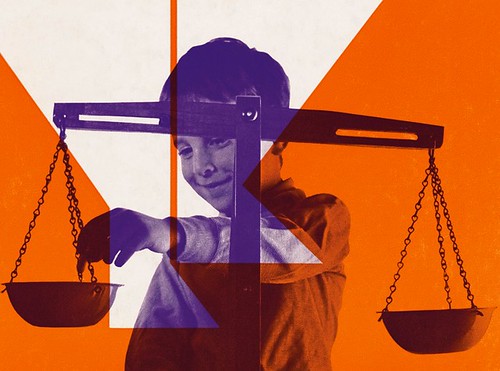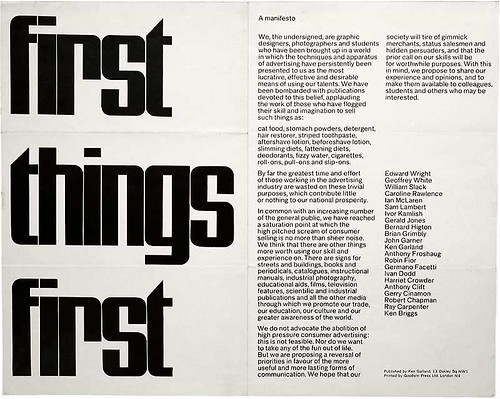Tuesday, 12:00pm
25 May 2021
The clarity of the innocent eye
In this previously unpublished essay from 2003, Ken Garland (who died last week) urges designers to be ‘alert’. In an afterword, Andrew Howard explains the context

I’ve been working as a graphic designer for 50 years, first as an art director on periodicals, from 1954-62, then as a freelance design consultant, from 1962 to date, writes Ken Garland. Has our trade / craft / profession changed much in that time? Of course it has; but how?
Take computer usage for a start. In 1954 a computer, typically, would occupy the whole floor of an office block, had to be instructed and receive data by means of elaborate punched cards or paper tape, and had as much connection with the practice of graphic design as a space rocket. The monstrous machine was tended by dedicated persons in white coats, who ‘spoke’ to it in a language we ordinary mortals did not know, as befitted a priestly elite. Meanwhile we pursued our own craft with pencil, ruler, gouache and spirit gum. And now? Now we spend long hours manipulating computer-generated imagery with keyboard and mouse, our gaze locked on to the user-friendly display on a monitor screen. Many of us have not seen a typescale or a sheet of layout paper in years.
What else has changed? Well, there’s the exponential growth of the ‘profession’ itself. In 1954 you could name all the established graphic designers working in the US (about 40 or so, I would guess) or the UK (say fifteen or twenty); but now there are thousands of us. We teem!
Ken Garland (right) at the Department of Typography & Graphic Communication, University of Reading, early 1980s. Photo from the collection of Rick Finlay.
Top. Photo of Garland by Gerhard Kassner, 2012. See Sarah Snaith’s ‘The Bloomsbury set’ on the Eye blog.

Then there’s the vastly wider scope of the work we currently undertake. In the old days we’d go into spasms of delight over the design of an itty-bitty compliments slip, or a title page, or the blurb on the back of a dust-wrapper. Now we grapple with nationwide – nay, worldwide – branding implementation, corporate design overhaul and multi-mixed-media experience. We’re into mega!
But I have to say that the biggest change of recent years has been the demystifying of our craft. Back then, aping the ancient and arcane practices of traditional guilds such as silversmithing, stonemasonry or printing, we graphic designers accrued to ourselves an impressive array of ‘mysteries’. Armed with our special, secret skills we retreated behind the doors of our studios and wrought magic deeds within, while our clients waited in ante-chambers, knowing their place. In the fullness of time we would emerge with The Answer. Clients could, of course, reject it; but only at the peril of losing deadlines and increasing costs, as we retreated once again into our studios for some more skilled brooding. Now, our clients presume to issue suggestions, corrections and even instructions over our shoulders, as we call up the umpteenth graphic alternative on our Macs.
Worse, they take our places at the workstations, doodle with drag-and-drop, conquer cut-and-paste, learn to layer text-and-image, master master-pages from the go-to-page pop-up menu and then, horror of horrors, discover design templates. Goddammit, they’ve become their own graphic designers! Just as we are replicating ourselves in myriad graphic design courses, we’re in danger of becoming surplus to need, the whole lot of us. And let’s not kid ourselves: in the cost-cutting culture to which we are consigned for the foreseeable future, no-one owes graphic designers a living. We’ll have to earn it the hard way.
Detail from work designed by Ken Garland & Associates for Galt Toys, late 1960s.

Okay, what is the way, hard or otherwise? I wish there were an easy answer. Perhaps the best thing is to tell you what is not the answer, and try to work from there. Narrow specialisation is not the answer. A dog-in-the-manger attempt to hoard special skills and deny them to the uninitiated is not the answer. Nor, on the other hand, is an Olympian assumption that we can produce the right, the only, solution to any problem, as the product of our uniquely brilliant imagination. Perhaps – and I am afraid I cannot be more positive than that – our proper role is that of the alert ignoramus.
‘But,’ I hear you cry, ‘how can ignorance ever be a saleable attribute for a graphic designer?’ That’s where ‘alert’ comes in. Linger for a moment on the synonyms for that admirable little word and I think you’ll see what I’m getting at: active, agile, attentive, careful, heedful, lively, observant, on one’s toes, on the ball, on the lookout, perceptive, sprightly … Now, there’s something to live up to, don’t you think?
Of course, we have to bring adequate skills and a grasp of the appropriate technology to bear on any job; but we cannot, at the outset, know all about any product or service which we are called on to publicise, or promote, or otherwise record in visual form. But we should – alertly – exploit that original ignorance, or innocence, which allows us to see and perform with clarity, and to pass on that clear perception to those other ignoramuses, the potential users of the product or service we are publicising.
As for imagination, brilliance, verve, inspiration – yes, we are going to need all that, and more. But first we must employ the clarity of the innocent eye.
yours, ken
Ken Garland (1929-2021), graphic designer, London
First Things First manifesto, 1964.

AFTERWORD
The main text above is a hitherto unpublished essay by Ken Garland, writes Andrew Howard. It was written soon after Ken’s participation as the first speaker in ‘Personal Views’ (2003-13), an international lecture series I curated in Porto that bought together more than 50 prominent designers, writers and educators in graphic design. I invited Ken to contribute to a book about the series (sadly never published) and the text typifies his unassuming, down-to-earth perspective.
Poster for Ken Garland’s ‘Personal Views’ talk in Porto, 28 February 2003. Design: Studio Andrew Howard.

Inviting Ken to be the first speaker in the series was not accidental. I had long held him in high esteem as the man behind the 1964 First Things First manifesto – just one of the lifelong contributions he made in his practice that promoted design as social practice, rooted in concerns more substantial than shopping. His choice as first speaker was to set the tone.
Thank you Ken for your persuasion and dexterity (in word and in image), for your resolve, steadfastness, and dedication to design as a collective enterprise, for your passion and spirit of celebration and, not least of all for your personal friendship.
Andrew Howard, graphic designer and teacher, Porto, Portugal
Eye is the world’s most beautiful and collectable graphic design journal, published for professional designers, students and anyone interested in critical, informed writing about graphic design and visual culture. It is available from all good design bookshops and online at the Eye shop, where you can buy subscriptions and single issues.
